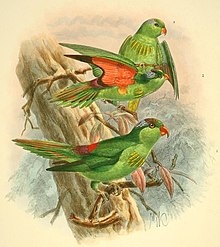| Pygmy lorikeet | |
|---|---|

| |
| Conservation status | |
 Least Concern (IUCN 3.1) | |
| Scientific classification | |
| Domain: | Eukaryota |
| Kingdom: | Animalia |
| Phylum: | Chordata |
| Class: | Aves |
| Order: | Psittaciformes |
| Family: | Psittaculidae |
| Tribe: | Loriini |
| Genus: | Charminetta Iredale, 1956 |
| Species: | C. wilhelminae |
| Binomial name | |
| Charminetta wilhelminae (Meyer, 1874) | |
The pygmy lorikeet (Charminetta wilhelminae) is a species of parrot in the family Psittaculidae. It is the only species placed in the genus Charminetta. It is found in the highlands of New Guinea; its natural habitat is subtropical or tropical moist montane forests. The world population of pygmy lorikeets is thought to be less than 50,000 individuals, but stable. They live at altitudes of 1000–2200m.
Taxonomy
The pygmy lorikeet was previously placed in the genus Charmosyna. It was moved to its own genus Charminetta based on phylogenetic studies published in 2020.
Description
The pygmy lorikeet averages 13 cm (5.1 in) in length (including tail) and 20 g (0.71 oz) in mass. It is the smallest of the lorikeets. The male has a dark purple rump and a streaked yellow breast, with red stripes under its wings. His tail is green tipped with yellow, and his eyes and beak are orange. The female lacks the red underwing stripe of the male, and has a green (rather than purple) rump. Immature birds are similar to adults in appearance but lack yellow streaking on their breasts and have brown bills and eyes.
Behaviour
They have high pitched, coarse, relatively weak flight calls. Pairs make quiet contact calls.
References
- BirdLife International (2012). "Charmosyna wilhelminae". IUCN Red List of Threatened Species. 2012. Retrieved 26 November 2013.{{cite iucn}}: old-form url (help)
- Parr, Mike (2003). Parrots: A Guide to Parrots of the World. Christopher Helm. pp. 252, 253. ISBN 0713669330.
- Smith, B.T.; Mauck, W.M.I.; Benz, B.W.; Andersen, M.J. (2020). "Uneven missing data skew phylogenomic relationships within the lories and lorikeets". Genome Biology and Evolution. 12 (7): 1131–1147. doi:10.1093/gbe/evaa113. PMC 7486955. PMID 32470111.
- Joseph, L.; Merwin, J.; Smith, B.T. (2020). "Improved systematics of lorikeets reflects their evolutionary history and frames conservation priorities". Emu - Austral Ornithology. 120 (3): 201–215. doi:10.1080/01584197.2020.1779596. S2CID 222094508.
- Gill, Frank; Donsker, David; Rasmussen, Pamela, eds. (July 2021). "Parrots, cockatoos". IOC World Bird List Version 11.2. International Ornithologists' Union. Retrieved 21 July 2021.
- ^ "Pygmy Lorikeets or Wilhelmina's Lorikeets - Beauty of Birds". www.beautyofbirds.com. 16 September 2021.
| Genera of parrots and their extinct allies | |||||||||||||||||||||||||||||||||||||||||||||||||||||||||||||||||||||||
|---|---|---|---|---|---|---|---|---|---|---|---|---|---|---|---|---|---|---|---|---|---|---|---|---|---|---|---|---|---|---|---|---|---|---|---|---|---|---|---|---|---|---|---|---|---|---|---|---|---|---|---|---|---|---|---|---|---|---|---|---|---|---|---|---|---|---|---|---|---|---|---|
| |||||||||||||||||||||||||||||||||||||||||||||||||||||||||||||||||||||||
| |||||||||||||||||||||||||||||||||||||||||||||||||||||||||||||||||||||||
| Taxon identifiers | |
|---|---|
| Charmosyna wilhelminae |
|
| Trichoglossus wilhelminae | |
This article relating to parrots is a stub. You can help Misplaced Pages by expanding it. |